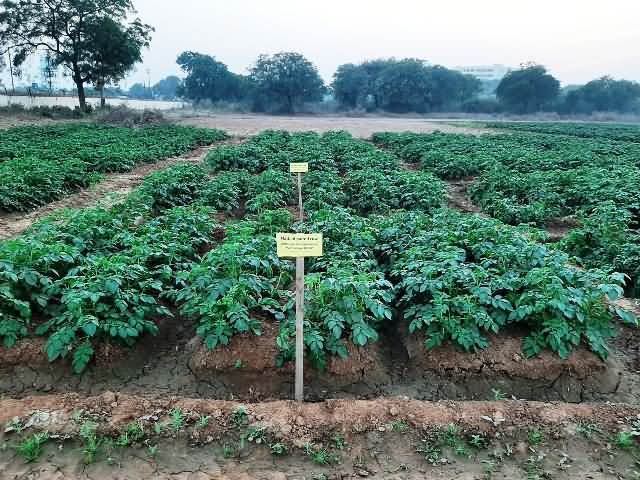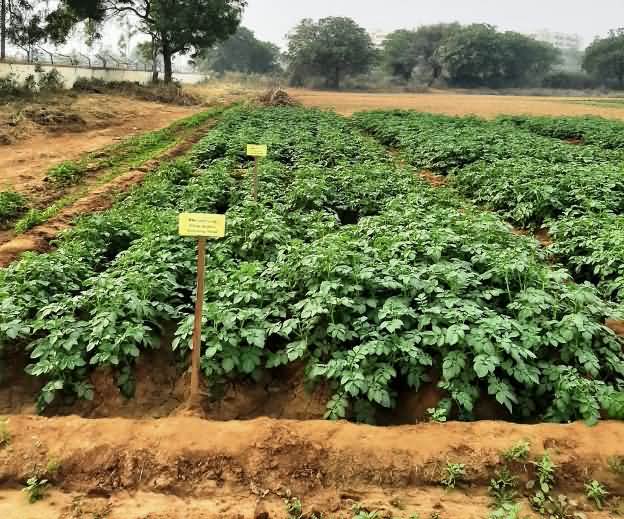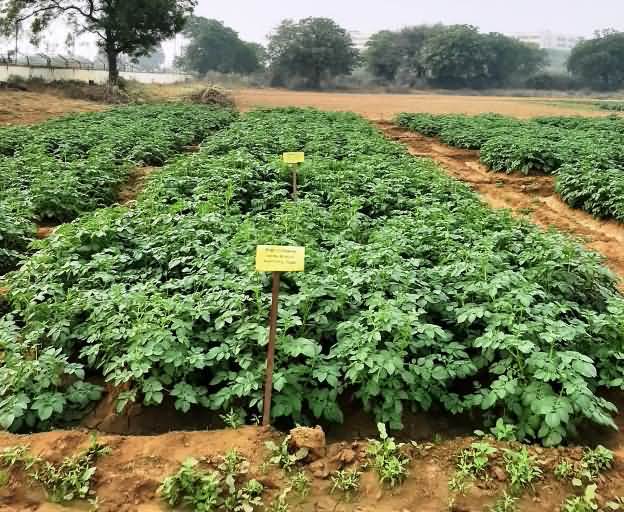आलू उत्पादन प्रणाली में बीज आकार के कंदों के उत्पादन के लिए प्रबंधन अभ्यास
Good quality seed is almost universally considered a requirement for high productivity in all potato production systems. Much of the yield gap currently constraining productivity is attributed to the poor quality of seed. Potato seed sector development is thus a major concern of governments, researchers, development agencies, and civil society organizations.
Seed is the most important part of the production cycle of many crops, including potatoes. Seed determines important factors such as yield, quality and overall crop health and has a direct bearing on the potato productivity. Selecting and planting clean, disease-free potato good quality seed is the first step to a successful crop year for potato growers.
Seed multiplication rate in potato is only 1:6 and production cost is very high due to stringent quality control. Seed production is very technical aspect and needs careful attention during all stages like date of planting, spacing, fertilization, top-dressing, irrigation, roguing, weeding, earthing up, spraying of pesticides, date of dehaulming, harvesting, etc.
Quality of seed potato is important for good yield therefore seed production; harvesting (haulming and harvesting) and storage should be carefully carried out. The average yield increase from the use of good quality seed is 30 to 50 percent compared to farmers’ seeds.
Sustenance, ensuring harvest and higher income are important quality attributes that farmers look for in both variety and seed source in potato. The seed accounts for 30 to 70% of the total production cost depending on the country or region and in India, it ranges from 40 to 50%.
The situation is further aggravated in high bulking cultivars Kufri Sutlej which has tendency to produce more numbers of over size tubers and Kufri Khyati which produces up to 50% under and over size tubers. Seed cost actually depends on seed size and intra-row spacing.
Seed tuber is the single most important factor in potato cultivation and if the seed does not possess good qualities, then optimum production could not be achieved. Potato yields are affected by several factors. Quality seed is a very important factor.
Significance of seed size tubers in potato
Size of seed tuber is an important factor to decide the seed per unit area because it affects total yield and graded or marketable tuber yields. Seed rate depends on the size of tubers used in planting for ware as well as seed crop. Standard seed tuber of 25–125 g weight (30–55mm) is rated as seed size tubers in India (IMSCS, 2013).
Appropriate seed tuber size has very important implication on potato production. The number of sprouts that develop from a seed tuber is influenced by the size of seed tuber. In larger tubers, growth is faster because of greater food reserve availability for each sprout and generally produce more sprouts which may result in the production of too many stems and eventually produce too many tubers.
If larger seed is used, a greater quantity of seed is required for planting per unit area. It is avoided because it increases seed costs and reduce planter’s accuracy. Conversely, smaller seed size tubers have less sprouts per unit due to the lesser amount of reserves available for sprout growth leading to small number of stems that produce only a few tubers, thereby reducing yield.
Big size seed will increase cost and seed that are too small may rot before emergence. Cut tubers may be deteriorate by fungal and bacterial infections and have less food reserve for the emerged plants which results to poor growth performance and lower yield.
The plantable tuber size for potato production is 30–50g for gaining maximum production potential from field. Small and medium size seed tubers are preferred by farmers engaged in small scale cultivation to reduce seed cost.
Many factors determine tuber size distribution such as number of stems per plant and the rate of crop growth which are difficult to manipulate. One of the most controllable factors is seed size. Low variation of tuber size is desirable in seed potato production.
Management practices for enhancing seed size tuber
Obtaining seed size tuber is important for achieving higher potential of the cultivars. The tuber size profile can be reduced or expanded by altering inter and intra row seed spacing, controlling days of growth by planting late or killing vines/haulm early, regulating inputs like fertilizer and water, applying growth regulators, and manipulating seed tuber physiological age.
When potatoes are grown for seed, cultural practices need to be used in order to maximize the proportion of seed size tubers and decrease the yield of large tubers. In practice, the space between the potato plants is manipulated by the number and size of the tubers planted which increased total yield, but decreased the percentage of large potato tubers that will be produced.
The possibility of ensuring a high yield largely depends on the maintenance of an optimal number of plants per unit area and their spatial arrangement in the field. In the present article different management aspects/ Agro-techniques of production of seed size/ plantable tubers is discussed.
1. Genotype/ variety
The genotype determines tuber number, tuber size and yield potential for any given cultivar. Varietal difference may occur for seed size tuber production as the cultivars vary in maturity and their bulking capacity. In terms of seed tuber percentage, Multa was the best (72.60%) followed by Ailsa (71.82%) and Dheera (71.74%) under Bangladesh conditions (Mahmud et al., 2009).
Kufri Jyoti (48.30%), Kufri Gaurav (44.60%) KufriLauvkar (49.39%) in 2018-19 and 2019-20 and K Chandramukhi (54.62%), K Chipsona-1 (49.72%) and Kufri Sindhuri (47.09%) during 2011-12 and 2012-13 under Gwalior conditions of Madhya Pradesh, India (Sadawarti et al., 2021b unpublished and Sadawarti et al., 2014).
This indicates the variation in tuber bulking ability in different genotypes resulting in variation in proportion of seed size tubers among different varieties. Cultivar can influence whether size or weight of minitubers will affect yield of progeny tubers.
2. Fertilizer combinations
Apart from the choice of cultivar, plant protection and continuous water supply, a further important agronomic measure for potato production is adequate nutrient management. Nitrogen (N), phosphorous (P) and potassium (K) are the nutrients which are most commonly applied in potato production. Proper management of N, P, and K fertilizers is considered very important to maximize tuber yield and attain desirable quality.
Increasing N supply can increase the proportion of large-sized tubers which is unfavorable for seed production. Potato yield can be divided into the three components: ‘number of stems per square meter’, ‘number of tubers per stem’ and ‘average tuber weight’, whereby N has the greatest impact on the average tuber weight. P has a significant impact on the setting of potato tubers, especially in the early growth states but also at later growth stages where P enhances tuber maturity.
Higher P fertilization rates decreases the yield of large-sized tubers. Most P is taken up between 40 and 60 days after emergence. A sufficient supply of K is also needed for high biomass production and leaf area development. Under K deficiency, there can be a decrease in the number of leaves as well as a decrease in the leaf size. This can be attributed to K’s role in osmoregulation and cell extension
The potato plant shows maximum uptake of K in early plant development, approximately 30 to 40 days after emergence. Variability in fertilizer combinations were observed for production of seed size tubers according to climatic regions in combination with planting geometries and vine kiiling pattern.
15 cm intra-row spacing × 70 days haulm killing × 120 kg N + 80 kg P2O5+ 100Kg K2O ha-1 and 150 kg N + 120 kg P2O5 + 80 kg K2O ha-1 recorded highest seed size tuber number and percentage under Gwalior and Modipuram conditions of India respectively and found to be most suitable combinations in seed production system for production of higher seed size tubers (Sadawarti et al., 2017 and Rawal et al.,2005)
3. Planting geometry/ density
Planting geometry influenced yield, tuber size distribution, number, stem density and net returns of potato cultivars. Optimizing of plant density is one of the most important agronomic practices of potato production, because it directs seed cost, plant development, yield and quality of the crop.
One way to adjust the size of tubers is to manipulate plant density. Increasing the planting density may lead to a decrease in the average weight of the tuber and the percentage of the large size. An ideal combination of plant population, row width, and in-row seed spacing for a particular variety were the major factors for optimizing tuber size and increasing grower’s revenue.
Planting of seed tubers on ridges is widely followed method with some modifications from place to place. As against single-row geometry of planting on each ridge, paired-row planting on ridges at different spacing has also been tested keeping constant or variable seed rates.
Seed size tubers (25–125 g) are very important for use as seed tubers in the successive crop season (Sadawarti et al., 2019). Different combinations of planting geometry were tried in different agro climatic zones/regions in India and around the world for getting higher proportion of seed size tuber and the details are given below.
Table 1 Effect of spacing combinations on production potential of seed size tubers
|
S.No. |
Agro-climatic zone/region/state |
Variety |
Spacing (cm 2) |
Plant population |
Yield |
|
1 |
Gwalior Madhya Pradesh, India |
Kufri Khyati |
60×20 cm |
83,333 |
50.75 % seed size tuber yield |
|
2 |
Patna, Bihar |
Kufri Pukhraj |
60x15 cm2 |
1,11,111 |
304400 and 17.67 t/ha seed size tuber number and weight |
|
3 |
Gwalior Madhya Pradesh, India |
Kufri Khyati |
60×15 cm |
1,11,111 |
405000 and 22.44 tha-1 seed size tuber number and weight |
|
4 |
Eastern Ethiopia |
Badhassa, Chala, Batte and Zemen |
50 x 25 |
80,000 |
8.63 t/ha |
|
5 |
Gwalior Madhya Pradesh, India |
Kufri Khyati |
15 cm intra-row spacing×70 days haulm killingx120 kg N |
1,11,111 |
427000 and 23.69 tha-1 seed size tuber number and weight |
|
6 |
Kilinochchi, Srilanka |
- |
60×20 cm |
83333 |
31% medium size tubers (40–55mm) |
|
7 |
Kukumseri Himachal Pradesh, India |
Kufri Joyti |
60×20 |
83,333 |
11.95 t/ha 25–50g seed size tuber yiels |
|
8 |
Bhatkada, Dadeldhura, Nepal |
Desiree |
30×20 |
1,66,667 |
97.25/M2 2.5–3.5 mm medium size tuber |
|
9 |
Amritsar, Punjab, India |
- |
60×20 cm2 |
83,333 |
163.3 q per ha |
|
10 |
Holetta, Ethiopia |
- |
50 x 20 cm2 |
1,00,000 |
242667 and 11.82 t ha-1 number and yield of medium seed tuber sizes |
|
11 |
Kufri (Fagu Unit), Shimla, HP, India |
Kufri Giriraj |
60×10 |
166 666 |
333000 and 156.4 q/ha seed size tuber number and weight |
|
12 |
Nadia, West Bengal India |
Kufri Himalini |
60 x 15 |
1,11,111 |
200463 (25–50g)141204 (50–75 g) tuber number/ha |
|
|
|
|
4. Haulm/ Vine killing
Haulm/vine killing is one of the criteria used in seed potato production primarily to regulate tuber size profile and is done to stop tuber growth in order to optimize seed size and to obtain a uniform size distribution with a maximum proportion of the tubers in the most profitable size class.
Vine killing is also done to reduce the risk of spread of viral infection by inhibiting plant-to-plant spread through vectors such as aphids. Where the growing season is short, haulm killing can be used to advance harvesting, obtain a suitable tuber size, strengthen tuber skins before harvesting, and prevent plant pathogens from spreading among the foliage and crop.
Haulm killing method is used for controlling tuber size, is easy to implement, and >70% of the tubers were distributed in the preferred size and is often carried out on unsenesced plants Haulm pulling to cut off the tubers from the roots was found to be most effective.
In different study conducted in India, 70-80 days of haulm killing found to be suitable for getting higher proportion of seed size tubers in different varieties
Conclusion
Size of the seed potato tuber plays important role in augmenting the production potential of potato cultivar. Narrow planting geometry with higher plant population, haulm killing after 70–80 days and nitrogen dose (120–150 kg/ha) and factor combinations need to be adapted for increased the seed size tuber number and weight in seed potato production system.
References
IMSCS., 2013. The Central Seed Certification Board Department of Agriculture and Co-operation Ministry of Agriculture Government of India, New Delhi, 2013, 340–344.
Mahmud, A. A., Akhter, S., Hossain, M. J., Bhuiyan, M. K. R., Hoque, M .A., 2009. Effect of dehaulming on yield of seed potatoes. Bangladesh Journalof Agriculture Research34(3), 443–448.
Rawal S, Lal S.S., Kumar,P., Upadhayay, N.C., 2005 .Agro-technology For maximizing seed size tuber yield Potato Journal 32, 3 – 4.
Sadawarti, M., Singh, R. K., Samadhiya, R. K., Singh, S. P., Pandey, K. K., Roy, S. Chakrabarti K., 2017. Maximization of seed size tuber production in early bulking potato (Solanum tuberosum L.) variety Kufri Khyati. International Journal of Bio-resource and Stress Management 8(6), 753-757.
Sadawarti M J, Singh R. K., SinghS. P., Samadhiya, R. K.,Katare S., 2021b. Effect of haulm killing date and variety on production of seed size tubers in potato (Unpublished)
Sadawarti, M.J. , Bhatnagar A., SinghS.P., Pandey K.K.,2014. Prospect of Early Planting of Potato Seed Crop in Central India. Indian Journal of Hill Farming 27(1):12-16.
Authors:
Murlidhar J Sadawarti1*, S P Singh1, R K Singh4, Tanuja Buckseth2, Subhash Katare1, R K Samadhiya1, YP Singh1 Sanjay Sharma1, Surender Singh1, Shyam Kumar Gupta1 Sanjay Rawal3and Vinay Singh3
1ICAR-Central Potato Research Institute, Regional station, Gwalior- 474020, Madhya Pradesh, India
2ICAR-Central Potato Research Institute, Shimla, 17100, Himachal Pradesh, India
3ICAR, Central Potato Research Institute, Regional station, Modipuram, Meerut, 250110, Uttar Pradesh, India
4ICAR, Indian Institute of Vegetable Research, Varanasi, 221305, Uttar Pradesh, India
*Corresponding author:

 Paired row spacing
Paired row spacing Normal spacing (60 ×20 cm)
Normal spacing (60 ×20 cm) Close spacing (60 ×15 cm)
Close spacing (60 ×15 cm)